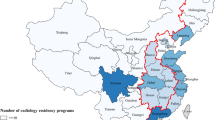Abstract
Objectives
To obtain an overview of the attitudes toward interdisciplinary further education of residents and consultants in radiology and nuclear medicine and preferences regarding a future joint training curriculum in Switzerland.
Methods
A 34-item questionnaire was sent electronically (SurveyMonkey online survey tool) to 1244 radiologists and nuclear physicians (residents and consultants) in Switzerland. The items asked about the motivation for further education in each other’s specialty and preferences regarding a joint further education curriculum in radiology and nuclear medicine.
Results
Overall, 370 questionnaires were analyzed (370/1244, 30%). There were 280 (76%) board-certified physicians in either radiology (238/370, 64%) or nuclear medicine (42/370, 12%) and 65 (18%) residents (radiology 54/370, 15%; nuclear medicine 11/370, 3%). More than half of all residents (34/65, 52%) stated their conviction that a wide range of expertise in both disciplines could be fully guaranteed through adequate cross-curricular training. For responders already at a consultant level in radiology or nuclear medicine, the willingness to undergo further training in each other’s specialty significantly increased with a shorter training period. The preferred option for a possible future joint training curriculum was a combination of a 5-year radiology training program with 2 years of further training in nuclear medicine.
Conclusions
Both residents and board-certified physicians in Switzerland are highly interested in a cross-curricular training curriculum in radiology and nuclear medicine.
Key Points
• A systematic survey was conducted to obtain information on interest in cross-curricular training in radiology and nuclear medicine and preferences regarding a future joint training curriculum.
• More than half of radiology and nuclear medicine residents would be interested in further training in the other specialty.
• There is a strong desire for a shorter training program when combining training in both radiology and nuclear medicine.




Similar content being viewed by others
Abbreviations
- CT:
-
Computed tomography
- ESR:
-
European Society of Radiology
- MRI:
-
Magnetic resonance imaging
- PET:
-
Positron emission tomography
- PET/CT:
-
Positron emission tomography and computed tomography
- PET/MRI:
-
Positron emission tomography and magnetic resonance imaging
- SPECT:
-
Single photon emission computed tomography
- SPECT/CT:
-
Single photon emission computed tomography and computed tomography
References
Krestin GP (2009) Maintaining identity in a changing environment: the professional and organizational future of radiology. Radiology 250:612–617
Gourtsoyiannis N, McCall I, Reiser M et al (2007) White paper of the European Society of Radiology (ESR) and the European Association of Nuclear Medicine (EANM) on multimodality imaging. Eur Radiol 17:1926–1930
Hricak H, Choi BI, Scott AM et al (2010) Global trends in hybrid imaging. Radiology 257:498–506
Dunnick NR, Applegate K, Arenson R, Levin D (2006) Training for the future of radiology: a report of the 2005 Intersociety Conference. J Am Coll Radiol 3:319–324
Alderson PO (2000) A balanced subspecialization strategy for radiology in the new millennium. AJR Am J Roentgenol 175:7–8
Larson SM (2011) The Janus project: the remaking of nuclear medicine and radiology. J Nucl Med 52(Suppl 2):3s–9s
Segall G (2012) Molding the future of the profession. J Nucl Med 53:17n
European Society of Radiology (ESR) (2012) Editorial on the revised European Training Charter for Clinical Radiology. Insights Imaging 3:5–6
ESR Executive Council 2009, European Society of Radiology (2010) The professional and organizational future of imaging. Insights Imaging 1:12–20
Margulis AR, Sunshine JH (2000) Radiology at the turn of the millennium. Radiology 214:15–23
Dalla Palma L (2006) Tomorrow’s radiologist: what future? Radiol Med 111:621–633
Mahmood S, Rodriguez Martinez de Llano S (2013) The changing landscape of nuclear medicine. Rev Esp Med Nucl Imagen Mol 32:46–48
Harolds JA, Guiberteau MJ, Metter DF, Oates ME (2013) Career prospects for graduating nuclear medicine residents: survey of nuclear medicine program directors. J Am Coll Radiol 10:593–598
Guiberteau MJ, Graham MM (2011) ACR-SNM task force on nuclear medicine training: report of the task force. J Nucl Med 52:998–1002
Jepson C, Asch DA, Hershey JC, Ubel PA (2005) In a mailed physician survey, questionnaire length had a threshold effect on response rate. J Clin Epidemiol 58:103–105
Clauser P, Mann R, Athanasiou A et al (2018) A survey by the European Society of Breast Imaging on the utilisation of breast MRI in clinical practice. Eur Radiol 28:1909–1918
Maurer MH, Zimmermann E, Schlattmann P, Germershausen C, Hamm B, Dewey M (2012) Indications, imaging technique, and reading of cardiac computed tomography: survey of clinical practice. Eur Radiol 22:59–72
Funding
The authors state that this work has not received any funding.
Author information
Authors and Affiliations
Corresponding author
Ethics declarations
Guarantor
The scientific guarantor of this publication is Martin Maurer, Bern University Hospital, Inselspital, University of Bern, Switzerland.
Conflict of interest
The authors of this manuscript declare no relationships with any companies whose products or services may be related to the subject matter of the article.
Statistics and biometry
Mrs. Anja Mühlemann, Department of Statistics, University of Bern, kindly provided statistical advice for this manuscript.
Informed consent
Written informed consent was not required for this study because no patient-related data was necessary for this study.
Ethical approval
Institutional Review Board approval was not required because it is only an anonymized statistical data and no patient data was used for this study.
Methodology
• prospective
• observational
• performed at one institution
Additional information
Publisher’s note
Springer Nature remains neutral with regard to jurisdictional claims in published maps and institutional affiliations.
Rights and permissions
About this article
Cite this article
Kim, S.Y., Xydias, T., Peters, A.A. et al. Radiologists and nuclear medicine physicians are looking forward to a cross-curricular training. Eur Radiol 29, 4803–4811 (2019). https://doi.org/10.1007/s00330-018-5989-7
Received:
Revised:
Accepted:
Published:
Issue Date:
DOI: https://doi.org/10.1007/s00330-018-5989-7




